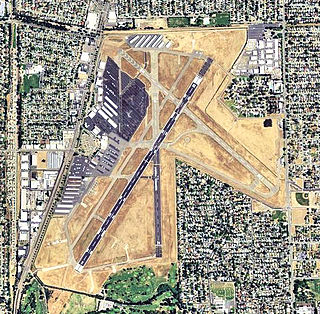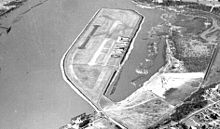
Portland International Airport is a joint civil–military airport and the largest airport in the U.S. state of Oregon, accounting for 90% of the state's passenger air travel and more than 95% of its air cargo. It is within Portland's city limits just south of the Columbia River in Multnomah County, 6 miles by air and 12 mi (19 km) by highway northeast of downtown Portland. Portland International Airport is often referred to by its IATA airport code, PDX. The airport covers 3,000 acres of land.

Boise Airport is a joint civil-military airport in the western United States in Idaho, three miles (5 km) south of downtown Boise in Ada County. The airport is operated by the city of Boise Department of Aviation, overseen by an airport commission. The busiest airport in the state, it serves more passengers than all other Idaho airports combined and roughly ten times as many passengers as the next busiest airport at Idaho Falls.

Frederick Douglass - Greater Rochester International Airport is a public airport located within the City of Rochester, three miles (4.8 km) southwest of Downtown, in Monroe County, New York, United States. It is owned and operated by Monroe County. The airport is home to the 642nd Aviation Support Battalion, part of the 42nd Infantry Division.

Troutdale Airport, also known as Troutdale-Portland Airport, is a corporate, general aviation and flight-training airport serving the city of Troutdale, in Multnomah County, Oregon, United States. It is one of four airports in the Portland metropolitan area owned and operated by the Port of Portland. Troutdale Airport was established in 1920 as a private airfield, then purchased by the Port of Portland in 1942. It serves as a reliever airport for nearby Portland International Airport (PDX).

Hillsboro Airport, also known as Portland–Hillsboro Airport, is a corporate, general aviation and flight-training airport serving the city of Hillsboro, in Washington County, Oregon, United States. It is one of three airports in the Portland, Oregon, metropolitan area owned and operated by the Port of Portland. Established in 1928, it is Oregon's second busiest airport at over 200,000 operations annually. HIO covers 900 acres and has three runways.

California Redwood Coast – Humboldt County Airport, also known as Arcata–Eureka Airport and Arcata Airport, is in Humboldt County, California, United States, 8 miles (13 km) north of Arcata and 15 miles (24 km) north of Eureka, in McKinleyville.

Hoover Field was an early airport serving the city of Washington, D.C. It was constructed as a private airfield in 1925, but opened to public commercial use on July 16, 1926. It was located in Arlington, Virginia, near the intersection of the Highway Bridge and the Mount Vernon Memorial Parkway, where The Pentagon and its northern parking lots now stand.

Cascade Airways was an airline in the northwest United States which flew primarily regional air routes out of Seattle, Washington. Founded in 1969, it operated for 17 years and was shut down in 1986. Its IATA code (CZ) was later assigned to China Southern Airlines which was formed two years after Cascade's shutdown.
Overlook is a neighborhood in the North section of Portland, Oregon on the east shore of the Willamette River. It borders University Park and Arbor Lodge on the north, Humboldt and Boise on the east, Eliot on the southeast, and Northwest Industrial and the Northwest District across the Willamette on the west.

Sacramento Executive Airport is a public airport three miles (5 km) south of downtown Sacramento, in Sacramento County, California, United States. The airport covers 540 acres (219 ha) and has two lit runways and a helipad.

Felts Field is a public airport in the northwest United States, located five miles (8 km) northeast of downtown Spokane, in Spokane County, Washington. It is owned by Spokane City-County.

Bernard's Airport, also known as Bernard Airport, was a non-commercial airfield in Beaverton, Oregon, United States, from 1928 to 1969. In its early years, it was one of two private airports located in Beaverton, the other being Watts Field, about one-half mile to the south of Bernard's Airport. The Bernard Airport site was redeveloped in 1969 as "Bernard's Beaverton Mall", now known as Cedar Hills Crossing.
Charles E. Bernard was an American aviation pioneer who developed Bernard's Airport, in Beaverton, Oregon, United States.

Imeson Field, also known as Jacksonville Imeson Airport, was the airport serving Jacksonville, Florida, from 1927 until its closing in 1968. It was known as Jacksonville Municipal Airport prior to World War II, Jacksonville Army Airfield when the United States Army Air Forces controlled the facility during World War II, and at its closing the airport was Jacksonville – Thomas Cole Imeson Municipal Airport.

The Kaiser Company , commonly known as the Swan Island Shipyard, was a shipyard on Swan Island in Portland, Oregon, United States. It was constructed by the industrialist Henry J. Kaiser in 1942 as part of the U.S. Maritime Commission's Emergency Shipbuilding Program in World War II. The Swan Island yard was one of three Kaiser Shipyards in the Portland area, along with the Oregon Shipbuilding Corporation and the Vancouver Shipyard.

Leah Hing (1907–2001) was the first Chinese American woman to earn her pilot's license. Trained by Tex Rankin, an early aviation pioneer at Pearson Field in Vancouver, Washington, she received her pilot's license in 1934. Later she became an instrument mechanic during World War II at a Portland air base.

Pearson Field also once known as Pearson Airpark, is a city-owned municipal airport located one mile (2 km) southeast of the central business district of Vancouver, a city in Clark County, Washington, United States.
Felts Field is an historic active airfield in the northwest United States, located on the south bank of the Spokane River, just east of Spokane, Washington.

Swan Island is located on the Willamette River about 4.5 miles (7.2 km) downriver from downtown Portland, Oregon, United States. Although presently connected to the Willamette's east bank by land fill, it existed as a river island under natural conditions.

The Swan Island Industrial Park is an industrial park on Swan Island in Portland, Oregon, United States. The industrial park comprises 430 acres (170 ha) and is operated by the Port of Portland.




















